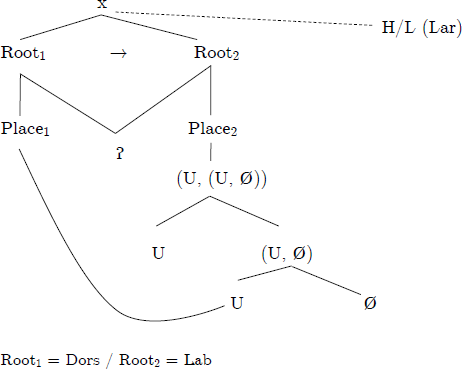1 Headedness, facts and interpretation
1.1 Phonetic signatures of labials and dorsals
According to the labial-velar hypothesis (Backley & Nasukawa 2009 (B&N); Backley 2011), Lab and Dor are both characterized by the same ‘dark’ Place feature |U| (akin to Jakobson & Halle’s (1956) grave).
It may be surprising for those who are trained to think in terms of articulatory features that in Element Theory (ET) Labials (Lab) and Dorsals (Dor) can be analysed as having the same Place feature. However, in a non-articulatory framework such as Element Theory, ‘place of articulation’ takes on a more abstract foundation than a physical ‘location’. Backley (2011), defines place features in terms of resonance features detectable from a sound’s spectral qualities.
This claim is primarily couched in phonetic terms, noticing that labial and dorsal consonants are relatively similar for some key acoustic properties. Most notably that they produce an acoustic modulation of a baseline ‘carrier signal’ (Harris & Urua 2001) in the same way. When comparing their spectral shapes, labials and dorsals produce the same ‘signature/shape’ (B&N).
| (1) | a. | Dorsal stop /k/ | b. | Labial stop /p/ |
 |
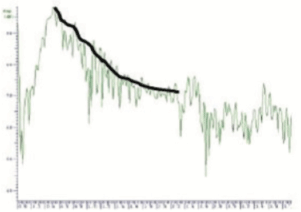 |
The dark element responsible for this signature is |U|, the same feature responsible for roundness and lowered formants in vowels. This natural affinity between labials and dorsals is also motivated by Jakobson & Halle (1956) who group these segments as a single ‘dark’ natural class (defined by the acoustic feature: [grave]).
Because the darkness signature is universally more robust in labials than it is in dorsals, B&N propose that labials have a headed instance of the dark element |U|, while dorsals have the unheaded version: |U|. According to this hypothesis, this difference in headedness is all that distinguishes /p/ from /k/ and various other labial/velar pairs of sounds.
1.2 Diachronic arguments for the labial-velar hypothesis
B&N point out that a benefit of their hypothesis is that certain historical changes do not need to be seen as unnatural, arbitrary feature substitutions.
One case they discuss is the equivalence between standard Swedish [tv] and the Lappfjärd dialect’s [kv]. They analyse this as a case of |U| spreading from /v/ to *t resulting in [kv]: tvättas vs. kvättas ‘to be washed’. Another case they discuss comes from Finnish. They discuss the sound change: ɣ → v between high round vowels: [u, y]. B&N point out that in articulatory feature terms, this process would be deemed unnatural, however, if the labial-dorsal hypothesis is correct, the process is a natural assimilation where the unheaded |U| of the velar fricative matches the surrounding headed |U| of round vowels. Other cases mentioned by B&N are historical equivalences that suggest an affinity between labials and velars: (a) Eng. lau[f] – Deu. la[x]en ‘laugh’ (cf. PIE klak), (b) Dut. lu[f]t – lu[x]t ‘air’ (cf. PGmc luftuz), (c) Lat. bos – PIE: gwōws ‘cow’, Ancient Gre. boûs ‘cow’ – boútūron ‘butter’ Eng. butter.
It seems that B&N’s labial-velar natural class arises frequently in diachrony. In fact, in addition to their evidence, more could be added. The labial component of many diphthongs [əʊ] comes from a historical velar consonant: (a) morr[əʊ] – morgen ‘morrow’ (via. Middle Eng. morwe), (b) marr[əʊ] Deu. mar[k] (cf. Old. Eng. mærg) ‘marrow’, (c) fall[əʊ] ‘fallow’ – Low Deu. falgen. (cf. Old English falgien) ‘fallow’, (d) fell[əʊ] – Old Nor. félagi (cf. Old Eng. fēolaga) ‘fellow’.
Preliminary reports on Assamese, also suggest that there is dialectal variation between [ŋ] and [ʊ̃]. In Urban Central Assamese and Eastern Assamese, we find the form [zaʊ̃] ‘I go’, while in Rural Central Assamese the form is pronounced [zaŋ] (Md. Sagir Ahmed 2018 (p.c.)).
There is also the equivalence between a ‘dark’ velar lateral in General Southern British English and its vocalized alternant [w] in Contemporary London English: fee[ɫ] – fee[w] ‘feel’.
For those who are taken by Substance Free arguments (Hale & Reiss 2008) or proponents of the Phonological Epistemological Principle (Kaye 2005), arguments from (acoustic) phonetic similarity are simply not phonologically relevant and neither are diachronic shifts.
In fact, there is a general reservation in accepting B&N’s labial-velar hypothesis because the evidence is almost entirely couched in diachronic facts. A synchronic argument based in alternations (or robust static distribution) is currently missing in the literature. What is mostly lacking is a synchronic alternation between velars and labials. There is, however, a compelling synchronic alternation between labials and dorsals that has not yet been recognized as evidence in favour of the labial-velar hypothesis.
1.3 Synchronic argument for the labial-velar hypothesis
Hyman (2017) discusses the case of Lusoga [JE16], a Bantu language. The case involves the reflex of Proto-Bantu *p. This can often correspond to [h], however, all its other reflexes in different languages are ‘dark’: [ɸ], [f], [β], [v], [w] and [ɣ] (ibid.).
The native Lusoga reflex of *p is [ɣ],1 however, it surfaces as the allophone [p] after a nasal consonant that is demonstrably underlyingly coronal/n/, as shown by the third column. The [p]/[ɣ] alternation is highly robust, it applies after the first person subject prefix and noun classes 9/10, and after the exponent of Past.
| (2) | 1.PL… | 1.SG… | 1.SG.PST… | Gloss | |
| /p/ | tù-pìm-á | m̀-pím-á | n-á-pìm-á | ‘measure’ | |
| /ɣ/ | tù-ɣ-á | ḿ-p-à | n-á-ɣ-à | ‘give’ |
This alternation also shows up in class 11/10 singular and plural pairs.
| (3) | SG ò-lú-ɣàɣá PL é-ḿ-pàɣá ‘feather’ |
This same alternation also shows up in reduplicated nouns and verbs in the formation of the pejorative (4). The same alternation can be shown in the diminutive and augmentative forms.
| (4) | Pejorative Reduplication | |||
| é-ḿ-pàɣá | ‘feathers’ | > | é-ḿ-páɣá + ɣàɣá | |
| è-m̀-púúmbú | ‘banana leaves’ | > | è-m̀-púúmbú + ɣúúmbú | |
| ḿ-p-à | ‘I give’ | > | ḿ-p-à + ɣ-á | |
| m̀-pét-á | ‘I bend’ | > | m̀-pét-à + ɣétà | |
Hyman’s discussion of the phenomenon centers on underlying forms, specifically the difficulty of deriving [p] from /ɣ/ in a post-nasal context. From an articulatory feature perspective this is indeed very tricky.
The difficulty centers on the origin of the labiality. Although the output is always: [mp], the underlying form of the nasal that triggers hardening is coronal (cf. ḿ-p-à ‘1.SG-give’ vs. n-á-ɣ-à ‘1.SG-PST-give’).
| (5) | ‘Magical’ appearance of labiality |
| n (coronal) + ɣ (dorsal) > mp (labial) |
One alternative to deriving [p] from /ɣ/ involves setting up very, very many allomorphs (Hyman 2017). While this is of course not impossible, an allomorphic approach is far less desirable than deriving /ɣ/ from [p] with a single productive rule.
B&N’s labial-velar hypothesis offers a startingly simple account for this alternation as a natural process, without an unmotivated substitution of place features. Though the specific details of the process would need to be worked out for the language, what is afforded by the Labial-Velar Hypothesis is that these alternations need not be necessarily the product of vast allomorphy or an unnatural/feature substituting process. Instead, it can be the result of a process that involves the (admittedly unexpected but theoretically possible) promotion of |U| to a headed status: |U| when the structure becomes bipositional. While this change is clearly more complex than /ɣ/ ➔ [k/g], it is still a natural process according to the labial-velar hypothesis since both /ɣ/ and /p/ contain the same basic feature |U|.
| (6) | Promotion of /ɣ/ to [p] in nasal hardening (spreading |ʔ| from nasal to the fricative) | ||||||
| H | – | Noise (burst, frication) | |||||
| ʔ | – | Occlusion/Silence (sustained reduction of amplitude) | |||||
| U | – | Darkness (Velar when non-head, Labial when head) | |||||
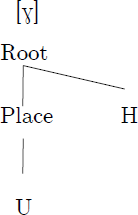 |
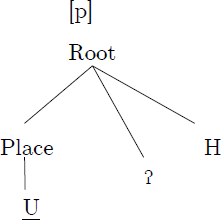 |
||||||
2 The Definition of Headedness
Since there are good reasons for thinking that labials and dorsals share a natural class, the representational differences between Labials and Dorsals should be made explicit.
If Dorsals and Labials share |U| as their only place feature, that means that there are a number of pairs of consonants that share all of the same features: /k/ & /p/ |H, ʔ, U|, /ŋ/ & /m/ |L, ʔ, U|, /x/ & /f/ |H, U|. And what of the class of labiovelar stop-stop consonants /kp, gb, ŋm…/, especially where these contrast with /k, p, kw…/.
Clearly different interpretational objects need to have unique underlying representations (when they are contrastive). However, since they appear to share all their features, the difference between these sounds needs to be expressed not in what the segment contains but the organization of those features. It is under these conditions that a headedness-based solution seems insightful. Since Labial has a stronger signature for the relevant feature, B&N claim that headed darkness |U| stands for Lab, and basic darkness is Dors. But what does it mean to be headed in phonology? How is headedness encoded at the abstract phonological level?
2.1 Previous approaches to Headedness
In much of Government Phonology (Kaye et al. 1990), the standard solution to headedness is purely notational. It involves underlining the headed element: |U| ‘non-head’ vs. |U| ‘head’. This is the most obvious example of what I will refer to as the diacritic approach to headedness.
A symbol (Feature) is further marked with a non-independent symbol to distinguish it. This creates a unique interpretation: U and U*, Uα and Uβ without introducing a new feature. This, however, begs the following questions: (a) what is the diacritic? (b) why does headedness work through a diacritic? (c) why is it not the other way around (with the diacritic marking the non-head).2 It is clear that beyond getting the answer right, the diacritic solution is a dead-end.
Competing against the diacritic solution are a whole family of different hypotheses that can collectively be thought of as isomeric solutions. These involve differentiating a feature set not by its contents but by their organization.
The clearest instantiation of this hypothesis is found in Charette & Göksel (1996; 1998) and Kaye (2001). The assumption is that speech sounds/segments, technically known as ‘phonological expressions’, are composed of an ordered pair, where O is ‘operator’/non-head and H is head.
| (7) | Headedness in Kaye (2001) | |
| Phonological expression (O.H) | ||
| Notation: ({Operator elements} Head) | ||
Unfortunately, this solution is still basically a notational solution because there is no explanation for how the structure is derived or why it exists as it does. However, this model does make two claims explicit: (a) no element may occur multiple times in an expression and (b) only one element may be the head of any expression.
Faust (2017) develops this approach and (to my mind correctly) interprets this notation as a template. We can therefore refer to this approach to Isomeric solutions as the Templatic solution. Building on Kaye’s (2001) ordered pairs, Faust (ibid.) proposes that every phonological expression in every language contains an operator and head position. The two positions in the template are metaphorically presented as ‘target’ and ‘base’. Unlike Kaye (2001), for Faust (2017) the same element can occur in both positions of the template and this leads to interpretative effects: [a] ({A} A) vs. [ə] ({A} Ø). What is still missing from this analysis is an explanation for why the template with its two obligatory positions exists at all and why should a three-way contrast not be possible: [a] ({A} A) vs. […] ({} A) vs. [ə] ({A} Ø)?
It seems to me that another instantiation of the Templatic solution is that of a Headedness tier. This option has been informally acknowledged in GP, though published attestations are hard to find. In Harris and Lindsey (1995) each element runs along its own tier. Harris (1994) shows this approach and has a good discussion of the tiers and the similarities and differences to feature geometry. Yoshida’s (2019) recent paper contains an example of this approach. This view starts with the assumption that elements are organized onto tiers.
| (8) |  |
In this way of understanding things, labials and dorsals would be different in one crucial way, the labials would have their |U| element projected to the Head tier, while dorsals would not. Similar to Faust (2017), this would mean that a head-tier is always present, though it may remain empty. In fact, it seems to me that this approach is a notational variant of the Templatic solution in Kaye (2001).
This viewpoint of headedness, also possible in Faust’s model, allows for an interesting reconciliation between those who think that velars have empty resonance (no place feature) and those who argue for them containing |U|. In this view, velars could be the only major place feature not to be headed (Backley 2017), therefore, velars could be unique in being both ‘empty headed’ and contain |U| at the same time.
| (9) |  |
In this model, just as in Faust (2017) the headed expression contains two instances of the headed element. This is a representational outcome of the Tier hypothesis and Faust’s (2017) version of the Templatic solution. In fact, this formal characteristic is shared by another approach to headedness and the novel solution that I propose.
The Tier based hypothesis shares a major problem with the Templatic solution. It still begs rather than answers questions, specifically: Why should elements be on ‘tiers’? What are the tiers? Why should there be a head tier? What does it mean to have a head tier and a dependent tier? Why are there two instances of the headed element? Why not put the headed element directly on the head tier? If that’s because the head tier is a projection, then what’s the actual structure.
2.2 Hidden templates
Moving away from templates, it seems logical that the simplest explanatory solution to the isomeric problem must come from general principles of combination and the first order (underived) geometric properties of the representation created by this combinatorial mechanism.
As Harris (1994: 149) states: ‘[headedness] is not a categorical term’, there is not a head-feature or a head-category, ‘rather it refers to a phonological function or relation, specifically one that is contracted between positions’. Knowing that, we start only with the phonological features (elements). Then we need to know how to arrive at these melodic ‘positions’.
The simplest combinatorial operation of any system is Merge (Chomsky 1995; Chomsky & Berwick 2016). Merge is demonstrably the best (and only) representation building device in syntax because syntactic representations are unordered and recursive (pace Gold et al. 2017 for special cases and discussion). In fact, syntax is recursive because it is built from the simplest operation, Merge. To restrict Merge’s application, one would actually have to add conditions to Merge, thereby making the system more complex (Chomsky 2011).
In this sense, phonological structures do not initially appear to be built directly by Merge. First, one of the two key defining properties of Merge is that it is recursive, but in phonological structures there is no clear evidence of true unbounded recursivity. Though there are plenty of phonological analyses that show you can use recursive structures to analyse phonological patterns (van der Hulst 2010; Nasukawa 2014; 2019), there are no phonological cases like ‘can eagles that fly swim’ that have to be represented with recursion/embedding (excluding linear adjacency).3
Nevertheless, it does seem to depend on which representational level one looks. At the supra-skeletal level, linear adjacency seems to be the only organising principle (Scheer 2013), however, at the sub-skeletal level, representations do have the same basic configurations as syntactic ones; with sisters, dominance, scope, branching nodes, terminal nodes and the whole ensemble is not linearly ordered (Sagey 1986; Lombardi 1991).
This apparent paradox can be made sense of if we consider Halle & Vergnaud’s (1980) core insight that phonological representations are built of melody (features) and a skeleton (positions), which is also the core of Strict CV representations (Lowenstamm 1996; Scheer 2004). Melodic and skeletal tiers are connected to each other, not by projection, but by association, as in a directed graph (Pierrehumbert 2011).
Curiously, there seems to be an architectural difference between the skeletal tier (which is linear and non-recursive) and sub-skeletal featural organization, which is not linearized (cf. Lombardi 1991). The sub-skeletal featural organization, in fact does look like a syntactic representation.
I will propose that melodic structures have the geometric properties they do because they are produced by Merge. I leave the discussion of why redundant, infinite and internally embedded structures are not generated to other work.
It appears, therefore, that melodic structure is actually homologus to syntax, a claim that is also made in other syntactic approaches to sub-segmental structure (though none of these limit recursion to sub-skeletal structure) (Pöchtrager 2006; Kaye & Pöchtrager 2013; Den Dikken & van der Hulst 2020; van der Hulst 2020) and the framework of Precedence-Free Phonology (Nasukawa 2019). Unlike all of these approaches I make this claim only about sub-skeletal i.e. ‘melodic’ structure.
Another thing that unifies these previous syntactic approaches to sub-segmental structure is that they invariably assume a melodic structure that is explicitly based on syntactic X-bar theory. The reason why this is not satisfying (to me) is that the X-bar schema is actually a template. The Minimalist program (Chomsky 1995 et seq.) has moved away from X-bar theory partly because templates like X-bar cannot be simply derived they must be stated, thereby deferring the question of why they are the way they are.
2.3 A new direction from old foundations
The new direction that I take should be contextualized by its antecedents in Dependency Phonology (Anderson & Jones 1974; Anderson & Ewen 1987). This framework takes the following as foundational: (a) asymmetry is one of the core empirical aspects of phonology (and linguistic systems in general), (b) A good way of modelling this asymmetry is by encoding it directly in the representation. My work in this paper is a continuation of this methodology, though I go about it in a new way.
Dependency Phonology noticed that asymmetry, or the Head-Dependent relationship is one of the most fundamental properties of (linguistic) phonological systems (ibid). In this framework it is assumed that in a constituent such as (γ (α, β)) the identity of γ will be of the category of either α, β. This constrains the system of possible constituents and defines headedness as a relationship between sisters. With the addition of a requirement for binarity, this means that representations would be entirely built out of Heads and a possible object that is adjoined to it (Anderson & Ewen 1987; van der Hulst 1989). Heads are therefore represented with a straight line and the dependent with a slanted line, something that continues into modern work in this framework (Van de Weijer 1996; Botma 2004; Kula & Liu 2020; van der Hulst 2020) and Precedence-Free Phonology (Nasukawa 2019).
| (10) | Headedness in Dependency Phonology (as shown in van der Hulst 1989) |
 |
The geometry of this structure emerges from the conditions of asymmetry and binarity that are imposed by UG. It is therefore a templatic statement that sisters will be universally asymmetrically organized into Head and Dependent. The headedness of the structure is encoded into the representation, rather than a consequence of it. The combination of two objects into a constituent means that one will effectively sit in the head-position, and the other in the dependent position.
This is different from the theory that I will present shortly where Headedness is a kind of asymmetry that is actually generated by language’s sole combinatorial mechanism, in fact, sisters can never be headed with respect to each other.
2.3.1 Merge but with another hidden template
Merge is defined in Chomsky (1995) as follows: target two syntactic objects: α and β, form a new object Γ {α, β}. The label (LB) of Γ(LB(Γ)) = LB(α) or LB (β). In this schema the head is the member of the set which decides/projects the label of the merged pair. Breit’s (2013) key contribution to the discussion of headedness comes from correctly considering the segment formally as a set of features.
For Breit (2013) if an element is a head it must also be contained in the overall set of elements; this follows from taking the implications of the carrier signal modulation (Harris & Urua 2001) seriously, in that the headed element (stronger modulation) will always imply the existence of a weak modulation (=dependent) (Breit 2019: 25). This leads to the following representations, which I believe are correct, though to avoid postulating headedness have to be derived differently.
| (11) | Headedness in Breit | ||
| |A, I| | = | {{A}, {A,I}} | |
| |A, H, ʔ| | = | {{A}, {A,H,ʔ}} | |
| |I, L, ʔ, N| | = | {{N}, {N,I,L,ʔ}} | |
The elephant in this definition in syntax is projection. Why should one of the labels be selected as the head? We only know that it is because it gets the right answer (Adger 2013; Chomsky 2014) but again it begs the question, why should there be projection at all?
This question is also applicable to Breit (2013)’s derivation of headedness. According to their model, headedness is based on the Kuratowski notation: ⟨a,b⟩ ≐ {{a},{a,b}}. This shows that Breit (2013) a priori stipulates that there is a head position. Therefore, as far as I can establish, this model presupposes projection of (a) in the a-headed structure {{a},{a,b}}. Therefore, all other merits notwithstanding, on the issue of headedness Breit (2013) is no more insightful than all previous approaches that merely assume that there must be a head position: |y, x|. It is another derivation of the Templatic solution.
Interestingly, it is possible to retain Breit’s (2013) key insight, without presupposing Templatic headedness.
2.3.2 Bare Element Geometry and the asymmetric theory of headedness
Just as Minimalist syntax has moved away from the templatic X-bar schema, it is possible to replace all the previous Templatic solutions (be they: x-bar, head-tier, obligatory head-position, or postulated head positions) with the equivalent of a bare phrase structure (Chomsky 1993). For phonology this is termed: Bare Element Geometry (BEG).
In Bare Element Geometry, elements can combine freely forming unordered sets. This means that the Merge operation that has been selected is the simplest of all possible operations, even simpler than Pair Merge that has been used in Minimalist Syntax.4
The structures that are generated will have the following configurations.
| (12) | Simplex Element | |
| a. | x | |
| b. | y | |
| c. | Configurations of Elements in BEG | |
| i. Set Merge: (α, β) = {α, β} | ||
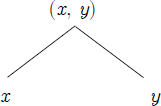 |
||
| ii. More Merge | ||
 |
||
Crucially, these structures are not formed from an x-bar schema or template. There is no dedicated ‘head’, ‘complement’ or ‘specifier’ position. The trees in (12) are composed only of features and the first order geometric relations that are produced by Merging the features together.
This is not to say that something like a ‘complement’ relation could not be identified in a structure built by BEG, indeed many other relations are feasible with the trees shown in (12). However, by hypothesis, these always have emerged from the first order geometric properties that result from their Merging. For instance, ‘headedness’ has been redefined as asymmetric c-command. Melodic features brought together by Merge (during the acquisition process) are universally binary and there is no contrast in directionality (right or left), they are unordered. In Bare Element Geometry there are elements and the ‘bare’ combinations thereof. Naturally this means that ‘headedness’ does not mean what it does in an x-bar schema.
Notice also that this leads to the same representational outcome as Breit (2013): {a, {a,b}}.5 It also preserves the key insight of the Isomeric/Templatic solution. In this approach self-merge is possible (Adger 2013), this can lead to structures such as (x, (x, x)). They will be discussed in more detail beneath.
2.3.3 Complexity in BEG and the asymmetric theory of headedness
In BEG there are two types of complexity: cardinality (13a–b vs. 13ci) and asymmetry (13cii). The Asymmetry here is what I understand to be the true definition of headedness.
One type of complexity is defined by cardinality: an empty, simplex or complex set. Assuming grammars cannot count, the difference is based on the binary opposition of an expression having either: (a) one element = simplex, or (b) more than one element = complex. This contrast is shown in (13a–b).
Another, entirely different complexity, is defined by asymmetry. The property that I think underlies ‘headedness’. This is defined at the level of the feature. A feature is a head if it asymmetrically c-commands another instance of itself (13c–d).
| (13) | Headed and Headless structures (as in ‘ATR’ headedness harmony systems) |
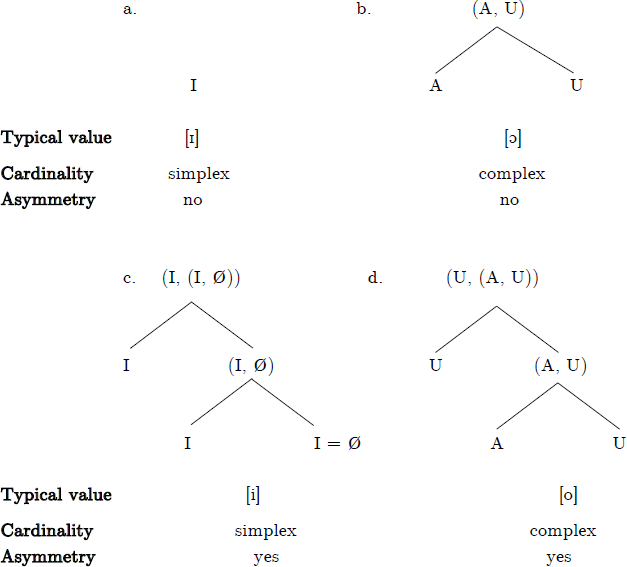 |
|
The structure in (13c) shows the outcome of self-merge. One application of self-merge will neither produce asymmetry, nor an increase in cardinality: (I, I) = (I, Ø) = I [Cardinality: 1 (simplex), Asymmetry: no]. Therefore, this will not lead to a phonological contrast. However, a second application of self-merge (or merge of the same element) will lead to phonological contrast, because although Cardinality cannot be increased, the outcome will be asymmetrical: (I, (I, Ø)) = (I, (I)) [Cardinality: 1 (simplex), Asymmetry: yes]. This is also why it is impossible to add another instance of merge and produce another phonological contrast since Cardinality will be the same and the structure will be just as asymmetrical as one level before: (I, (I, (I, Ø))) = (I, (I, (I))) [Cardinality: 1 (simplex), Asymmetry: yes].6
Although this model does allow structures with more than one of the same element (contra Kaye 2001), in this system, simplex expressions could still never have a chiral contrast: |A, A| vs. |A, A|. This is because in this model, headedness can only result from asymmetric c-command and (A, A) = (A, A).
2.4 Empirical predictions of BEG
In BEG there are two types of complexity: Cardinality and Asymmetry. These are entirely independent properties. This will mean that simplex expressions can be headed or headless (depending on whether they are asymmetrical or not) (14a). Also, expressions that are complex in cardinality do not necessarily have to have asymmetry. This creates a three-way contrast in mid-vowels (14b).
| (14) | a. | |I| | (I, (I, Ø)) | |
| b. | (A, I) | (A, (A, I)) | (I, (A, I)) |
This typological three-way contrast appears to be attested. For instance, take a phonetic [ɛ], where it patterns phonologically with [ɪ, ʊ…] in opposition to [e, i, u…], as happens in many ‘ATR’-harmony languages (Casali 2008) (15). In Gɪsɪda Anii, the open mid vowels pattern with the close-mid lax vowels suggesting their representation is also without asymmetry: (A, I). Whereas the lenition pattern in Tuscan Italian (16) clearly suggests that phonetic [ɛ] is A-headed (asymmetrical in this model).
| (15) | Symmetrical [ɛ] – ATR harmony Gɪsɪda Anii (Morton 2012)7 | |||
| a. | ATR | b. | -ATR | |
| i | ɪ | |||
| u | ʊ | |||
| ə | a | |||
| o | ɔ | |||
| e | ɛ | |||
- (16)
- Asymmetric [ɛ] – Tuscan Italian

| a. | bɛ́ɾtʃo | ‘shout.1PS’ | b. | beɾtʃá ‘shout.INF’ |
As shown in Gɪsɪda Anii (15a) the ATR harmony system is sensitive to Asymmetry. This categorizes the phonetic [ɛ] as a member of the symmetrical set: (A, I) cf. (cf. [ɪ] = |I| vs. [i] = (I, (I, Ø)). Conversely, vowel reduction in unstressed syllables is typically seen as a reduction in complexity and structure. As such, since it is the open mid vowels that are not permitted in unstressed position, it suggests that Tuscan’s open mid vowels are underlain by more structure than [e], not less (Harris 1997; Pöchtrager 2018). This categorises Tuscan’s phonetic [ɛ] in the Asymmetric set: (A (A,I)).
The conclusion is that the phonetic [ɛ] is symmetrical (A.I) in Gɪsɪda Anii and asymmetrical (A (A.I)) in Tuscan.
2.4.1 Two types of vowel reduction
The structures in (13) predict that there should be two basic types of vowel-reduction, those that affect Cardinality and those that affect Asymmetry. Exactly this contrast exists in Brazilian Portuguese (BP) vowel reduction in different prosodic positions: pre-tonic and post-tonic.
BP stressed positions can contain any of its seven vowels: [i, u, a, e, o, ɛ, ɔ] including headed and headless mid-vowels (Nevins 2012). In pre-tonic position, only a reduced set of five vowels are permitted: [i, u, a, e, o].8 Cardinality is unaffected, so the reduction is presumably in asymmetry. However, in post-tonic environment only /i, u, a/ [ɪ, ʊ, ə] are permitted.9 This reduction appears to (also) affect Cardinality.
| (17) | Headedness and cardinality in Brazilian Portuguese | ||||||
| Pre-tonic | Tonic | Post-tonic | |||||
| i, u, a, e, o | i, u, a, e, o, ɛ, ɔ | ɪ, ʊ, ə | |||||
| Asymmetry | ✖ | ✔ | ✖ | ||||
| Cardinality | ✔ | ✔ | ✖ | ||||
| *(A(A.I)) | *(A.I) | ||||||
2.5 Theory internal advantages
Before moving to the relevance of BEG for labial-velar consonants, in light of the labial-velar hyptothesis, I will explain a few framework internal benefits of BEG. The problems that it solves are not always found in the published literature, but they are common spoken about ‘problems’ in GP circles. No attempt is made to make the problems intelligible to those not familiar with the framework, however, the section is short and the disinterested reader is encouraged to skip it.
One benefit of BEG is that it easily avoids the formal difficulties of empty-headed expressions. This is expressed as: how can structures be unheaded if they have a universal empty head position? According to asymmetric-headedness, symmetrical pair merge: {a,b} = (A,I) simply has no head.
Another benefit of the asymmetric-head hypothesis, is that Bare Element Geometry avoids the paradox of having empty expressions (Ø) in languages that also have the licensing constraint: ‘all (phonological) expressions must be headed’ (Charette & Göksel 1998). This is traditionally problematic because if all phonological expressions must contain a head, empty expressions ought not to exist at all. However, this problem cannot even be formulated in BEG,10 because this licensing constraint would be expressed as a condition on nodes (as shown in (18)). Since, empty expressions have no nodes, the condition in (18) does not apply to them.
| (18) | All Expressions Must Be Headed |
| All nodes must be asymmetrically c-commanded. |
Another good outcome of BEG is that it automatically predicts that empty expressions cannot be headed. There can be no expressions with an empty head ‘lording it over’ non-headed elements. This is a difference with all Templatic solutions, including Breit (2013: 23). In this model, such a structure cannot even be formulated. In BEG, headedness is a relational property among nodes in a tree (and not ‘a position’); therefore, if there are no features, there can be no head.
3 BEG and labial-velars
3.1 BEG and the labial-velar hypothesis
Returning now to labial and dorsal consonants, we see that in this model labials and dorsals have the same cardinality, but radically different structures. In fact, dorsals are a structural subset of labials.
| (19) | Labial and Dorsal place features |
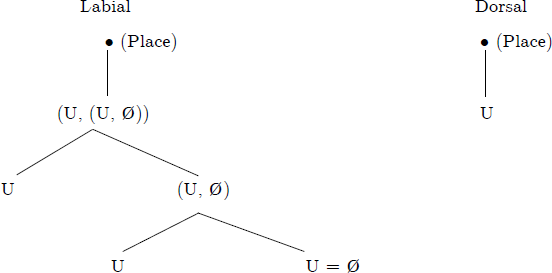 |
3.2 The phonology of KP
In this section, I will present the evidence for the representation of KP step-by-step. Each assumption is built not on its phonetic identity but its phonological behaviour.
For expository reasons, [kp] and [gb] will be collectively called KP, unless I need to exclusively referring to either [kp] or [gb] specifically.
3.2.1 KP is a single segment
Where it can be tested, KP can be shown to be a monopositional segment linked to a single C-slot/position. It is not a consonant cluster. Ewe shows good evidence for this, the rare combination of linguistic properties allow us to test this directly.
Many languages reduplicate KPV syllables along with CV syllables (e.g. kpa-kpara & pa-para). However, in order to show that KP is a single segment, CV reduplication needs to be properly distinguished from initial syllable reduplication, which would copy both singleton and complex onsets. Many languages with initial CV reduplication cannot actually be disambiguated from initial syllable reduplication because either they have the reduplication pattern but not the clusters, or the clusters but not the reduplication pattern. Ewe is special because it has both and it allows us to see the true segmental identity of KP.
| (20) | Ewe CV reduplication (Ansre 1963 via Cahill 1999: 157) | ||||
| a. | fo | ‘beat’ | fo-fo | ‘beating’ | |
| b. | bia | ‘ask’ | ba-bia | ‘asking’ | |
| c. | fle | ‘buy’ | fe-fle | ‘bought’ | |
| d. | kplo | ‘lead’ | kpokplo | ‘leading’ | |
| e. | gbla | ‘exert self’ | gbagbla | ‘exerting self’ | |
Examples (20a–c) show the initial reduplication. Without any other evidence, these could be analysed either as initial CV or initial syllable reduplication. However, in (20c) we see that the pattern must be initial CV reduplication because the initial cluster /fl/ is split in the reduplication. Having established that this is a pattern of initial CV reduplication, we can test the KP clusters. We see that the whole KP is reduplicated as a single consonant and unlike a cluster (20d–e).
3.2.2 KP has two place nodes
Having established that it is a single segment, the fact that it has two phonetic places of articulation becomes a problem, since segments typically have a single place feature. Sagey (1986) and McCarthy (1988) hypothesize that this is caused by a branching Place node. However, I think there is evidence to suggest that KP have two place nodes, rather than a single branching place node.
The evidence comes from a lesser-known Bantu language, Nzadi spoken on the Kasai River in the Democratic Republic of Congo. The pattern is reported by Crane et al. (2011), but its significance for the number of place nodes in KP has not previously been reported.
Nzadi has a series of rare and complex segments amongst more common affricates and prenasalised stops; it also has KP (Crane et al. 2011: 24).
| (21) | Stops, affricates and KP of Nzadi (shown in pairs) | ||||
| a. | epim | ‘fish (sp.)’ | ebim | ‘already’ | |
| b. | ɔtɔk | ‘pipe’ | ndɔk | ‘sorcery’ | |
| c. | o-tswâ | ‘to bring’ | o-dzwâ | ‘to kill’ | |
| d. | ŋkáb | ‘paddle’ | ŋgûl | ‘big’ | |
| e. | mpfùú | ‘bird’ | ibvuk | ‘monkey (sp.)’ | |
| f. | okpé | ‘short’ | ŋgbee | ‘side’ | |
What is special about Nzadi is that nearly every consonant can come ‘coloured’ by a secondary place feature: /j/ or /w/. This includes the affricates and the prenasalised stops, however, crucially it does not include KP.
Although there are a few accidental gaps: *pfw, *vw, there is no generalized ban on labials being secondarily labialized, nor is there a dissimilation effect banning secondary palatalization (/j/) after labials: /pj/ and /pw/ are both attested. The data in (22) lists some dark and light coloured consonants, as well as a representative set of coloured affricates.
| (22) | Secondary articulation of consonants (Crane et al. 2011: 24)11 | |||||
| C+j | C+w | |||||
| a. | pjoo | ‘black’ | o-pwɔn | ‘to decay’ | ||
| b. | osja | ‘beautiful’ | oswâ | ‘tomorrow’ | ||
| c. | o-kjá | ‘tail’ | ŋkwɔ̂n | ‘bean’ | ||
| d. | mpfjô | ‘cold’ | ||||
| e. | ibvjo᷈ | ‘breast’ | mbwa /mbvwa/ | ‘path’ | ||
| f. | o-tsjak | ‘to pour’ | otswâ | ‘to bring’ | ||
| g. | ndzjɛ̌m | ‘bat’ | o-dzwâ | ‘to kill’ | ||
Nzadi is a language that is rich with complex segments, but outside of this secondary consonant colouring, KP is the only segment with two place features (vs. mpf = Lab, bv = Lab, ts = Cor, ndz = Cor).
Since the core parts of the segment are not affected by the secondary place of articulation, I assume that this extra place feature is adjoined to the segment as a whole. I therefore assume that the ban on colouring KP is caused by a maximal number of Place nodes per segment.12 The way that this is represented will not be obvious until the next section.
3.2.3 KP has two Root nodes
The data from Nzadi suggests that KP has two place nodes but the distribution of those place nodes in the segmental structure is not immediately clear from that data.
There is evidence, however, for KP being made up of two ordered Root nodes, each with its own place node. This is unexpected because it runs against all previous descriptions of the sound (Sagey 1986; McCarthy 1988; van de Weijer 1996; Cahill 1999).
3.2.3.1 Background to place features in KP
As a way to restrict the universal set of complex segments, Sagey (1986: 61) stipulates that only terminal features can branch, class nodes cannot. She therefore excludes branching root nodes and proposes that KP has a branching place node instead.
| (23) | KP (Sagey 1986: 61) |
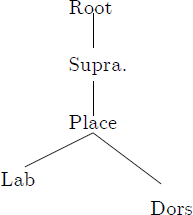 |
Opting for this structure yields predictions, chief among which: (a) the place features of KP must be unordered with respect to each other (Sagey 1986: 61) and (b) the whole KP segment must share all the features that link directly to the root node.
The kind of unordered representation shown in (21) has proven very successful in limiting the universal set of complex segments, especially affricates. It is indeed true that complex segments almost always have agreeing voicing values: */pv, bf, tz…/.13 Because this fact about voicing is true for all three major types of complex segments (affricates, prenasalised stops and labial-velar stops), there is a tendency to lump these three classes of sounds together.
This tendency is further reinforced by the fact that these three types of sound demonstrably sit beneath a single timing slot.14 However, it does not follow, that these three complex segments should have an identical structural organization beneath the timing slot.
Indeed, it has often been observed that complex segments can only vary for one feature: either they have complex place: [kp], or they have complex manner: [ts], but not both: *[kʑ].
This would be a strange condition for generative grammar: if the terminal features are unrelated to each other and each terminal feature can branch, then why can they not both branch in the same representation?
Furthermore, I have not seen it claimed elsewhere, but it seems that affricates and prenasalised stops seem to very rarely have a branching place feature: *[pʒ, tf, kz, …], *[md, np, …].15 This may turn out to be a formal limitation on affricates and prenasalised stops but it is clearly not a limitation on labial-velar stops. This shows that while these three types of sound are all complex segments (a natural class defined by being dominated by a single C/skeletal slot), these types of sounds can have different conditions/restrictions on their internal structure.
The next subsection attempts to show that this difference between affricates/prenasalised complex segments and KP is at the level of the Root node. The former have one root node, while KP has two. As I said in the head of this section, Sagey (1986: 61–62) choses the one-root-node-branching-place-node hypothesis because she wishes to limit the possibility of branching class nodes.16 Her hypothesis comes with two predictions that are not shared by a two-root-node hypothesis: (a) the place features of KP must be unordered with respect to each other, and (b) the whole segment KP must share all the features that link directly to the root node. Interestingly, though this has not been previously recognized, both of these turn out to be mispredictions for KP.
3.2.3.2 KP’s root nodes are ordered
Cahill (1999) lists the assimilatory behaviour of nasals before KP in many languages. Crucially, this is a two-way, not a three-way, typology.
In many languages nasals assimilate only to the velar portion of the complex: [ŋ]KP. Languages like this include: Anufo (Chakosi), Birifor, Chumburung, Dagbani, Deg, Ga, Gwari, Konkomba, Kusaal, and Vagia (Cahill 1999). To this list, I can further add Fang (Mve 2013: 22), Mbum (Hagège 1970) and Nzadi (Crane et al. 2011). Meanwhile, in many other languages the same sequence results in [ŋm]KP e.g. Kpelle, Yoruba, Dan, Sango, Tiv, Gwandara (Cahill 1999). To this list I can add Mono (Olson 2005)17 and Vai (Welmers 1977). These are summarized in the table (24) beneath.
- (24)
- Assimilation typology between nasal + KP

There are two patterns of nasal-KP assimilation when a priori we could have expected three: n + KP = (a) [ŋ]KP, (b) [ŋm]KP or (c) *[m]KP. There is the complete place assimilation where the nasal agrees for both of KP’s place features, resulting in [ŋm]KP. Then there is partial agreement for place, where assimilation targets just one of KP’s features, but it is always the same one: Dors. Since Lab is an inherently stronger cue, both acoustically and visually, this gap only makes phonological sense if KP’s two place features are ordered and assimilation either targets the whole segment with its two Place features or the closest place feature out of an ordered pair: Dors. Crucially this pattern fails to be explained by all previous representations of KP which have unordered place features.
If Dors and Lab features were unordered under a branching place node as Sagey (1986) suggests, then, as well as global assimilation of both Lab and Dors, we should counterfactually expect either place feature to assimilate to the nasal, since they would both be local. This would create the unattested three-way typology modelled in (23a). Conversely, if Dors and Lab belong to two ordered Root nodes, as shown in (23b), then only Dors is local to a leftward nasal. Under these conditions, only one type of partial assimilation is expected: Dors.
This typology also shows a nice non-vowel harmony application of the logic of feature spreading found in Nevins (2010) for vowel harmony. This also operates via Agree according to the principle of locality. What the structure in (23b) shows is that a nasal seeking a place feature can only take Lab if it also takes Dors, which it would have to cross-over non-locally to reach.
| (25) | Locality and nasal assimilation | |
| a. | Agree in an Unordered structure (Sagey 1986) (overgenerates)18 | |
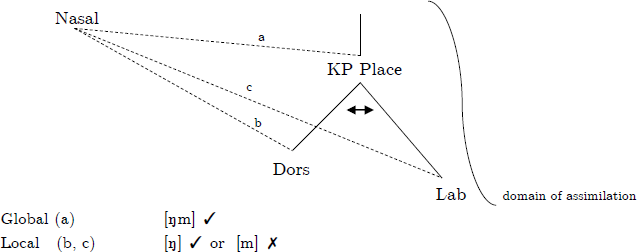 |
||
| b. | Ordered (correct) | |
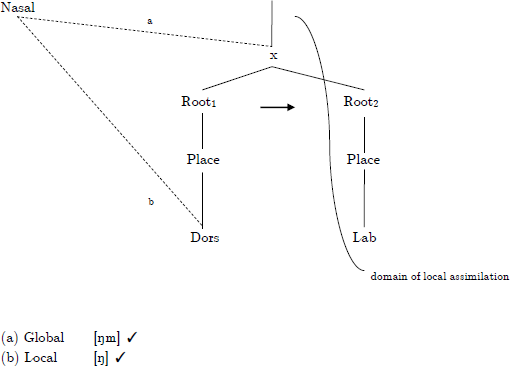 |
||
The ordered root node analysis is particularly convincing given that it applies symmetrically on the right side. In rightwards nasal assimilation (KP + nasal), the nasal again assimilates either locally (m) or globally (ŋm). Cahill (1999), citing Mills (1984), reports that KP followed by nasal results in /m/ in the Tyebaara dialect of Senufo: [kpmɔ̰́ː] ‘to beat’, [nḭ̀-gbmɔ̰̀ː] ‘herb doctor’. He also reports that Mada has an underlying syllabic /m/ which assimilates to the place of its onset. In the case of /k/, the syllabic nasal becomes dorsal [ŋ] (26a), while after KP it becomes [ŋm] (26b–c).
| (26) | KP + nasal assimilation in Mada (Price 1989) | |||
| a. | /kpakmki/ | [kpakŋki] | ‘tree stump’ | |
| b. | /kpm̀/ | [kpŋm̀] | ‘kapok tree’ | |
| c. | /gbm̀/ | [gbŋm̀] | ‘canoe’ | |
Again this local or global assimilation pattern shows that the Dors and Lab place features of the KP are phonologically ordered with respect to each other: Dors > Lab.19
3.2.3.3 KP formation
In this section, I will explain three pieces of evidence for KP’s two-root node structure taken from its phonological behaviour. The first case study is reported as a diachronic fact in Cahill (1999) but it could also be analysed synchronically. From the reported data, it seems that Aghem roots can be made plural by the addition of a /w/ (which I assume comes with its own root node). The combination of the target consonant and /w/ create a two-root node complex (Cahill assumes: pw), this is then converted into or interpreted as KP.
| (27) | Aghem labio-dorsal formation | ||||
| Singular | Root + Plural | Plural | Gloss | ||
| a. | kɨ́-nâŋ | ó – √n + w + aŋ20 | ó-nwâŋ | ‘cocoyam’ | |
| b. | kɨ̀-tɛ̌ɛ | ó – √t + w + ɛɛ | ó-twɛ̌ɛ | ‘cricket’ | |
| c. | kɨ́-báʔ | ó – √b + w + aʔ | ó-gbáʔ | ‘rope’ | |
| d. | kɨ́-bɛ́ | ó - √b + w + ɛ́ | ó-gbɛ́ | ‘fufu’ | |
3.2.3.4 Distributional argument
The second argument for KW/GW and KP’s two place nodes comes from phonotactics. In a number of languages, there are strict phonotactic conditions on the distribution of KP. For instance, in Nabak (Huon, PNG), KW and GW (which are optionally pronounced as KP/GB) cannot be located in word-final position, unlike singleton stops P, T, K.
The most likely explanation for this skewed distribution is that segments with two root nodes cannot occur in word-final position. This is a reasonable phonotactic distribution, given that the word-final position is canonically weak and weak positions can host less material than strong positions (Harris 1997).
3.2.3.5 Separatability in Guere
The third case-study is perhaps the strongest argument for KP having two root nodes. It comes from KP’s allophony in Guere. The facts of Guere are robust and simple, though their interpretation does involve a quick foray into the representation of nasality in feature geometry.
In Guere, a Western Kru language, [gb] and [kp] both have nasal allophones when they appear as onsets of nasal vowels. The sound /gb/ surfaces as [ŋm] before nasal vowels, while/kp/ surfaces as [km] (Paradis 1983: 16).
| (28) | Guere labial-velar allophony (Paradis 1983: 30, 53, 33, 32 tones as in original) | |||
| a. | kpʊ˦ | ‘back (part of body)’ | ||
| b. | kpa˩u˥ | ‘corn’ | ||
| c. | gbe˧ | ‘dog’ | ||
| d. | gba˧a˦ | ‘goat’ | ||
| e. | /kpʊ̰˧/ | kmʊ̰˧ | ‘to catch’ | |
| f. | /gba̰a̰˩/ | ŋma̰a̰˩ | ‘to raise/educate (children)’ | |
| g. | kplõ˩˥ | ‘banana’ | ||
As the data in (28a–d) shows, Guere has both /kp/ and /gb/ before oral vowels. However, before nasal vowels these are allophonically produced with nasalization.
Crucially, the voiced /gb/ nasalizes fully, meanwhile /kp/ only part-nasalizes. The vector of this change makes phonetic sense, voicing and nasality are inherently related properties (Ploch 1999; Nasukawa 2005), so it is phonetically natural that the voiced /gb/ nasalises to a greater extent than /kp/, but what is significant from the phonological perspective is that it is possible to half-nasalize KP.
Nasal (Nas) is a feature that links quite high in the segment. Classically, it was assumed to link (directly or indirectly) to a Supralaryngeal node. In any case, Nas was above the Place node (Clements 1985; Sagey 1986; Archangeli & Pulleyblank 1986). In fact, Piggott (1987) convincingly argued for linking Nas directly to the root node. This approach was adopted into McCarthy (1988)’s feature geometry overhaul.2122
If the near consensus that nasality is a root property is correct, then the ability for a segment to half-nasalize is good evidence for KP’s division into two root nodes. Any analysis based on a branching Place node (Sagey 1986; McCarthy 1988; van de Weijer 1996) simply mispredicts this phonological outcome. They predict that nasality ought to always span over both places of articulation. According to standard assumptions, the nasal feature ought to link to the supralaryngeal node (Sagey 1986) or the Root node itself (McCarthy 1998; van de Weijer 1996). In all cases, it should equally affect both components of the stop.
| (29) | KP based on Sagey (1986) |
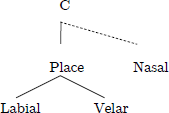 |
| (30) | KP based on McCarthy (1988) |
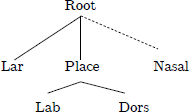 |
Meanwhile, my representation of KP is based on two roots which sit under x (used here as a theory neutral marker of the skeleton). Two root-node structures have a precedent in van de Weijer’s (1996) work, where they are employed for short diphthongs and other sounds (e.g. ibid. 1996: 205), though not for KP. It is possible that a number of van de Weijer’s (1996) analyses would be directly translatable with the structures predicted by BEG. This hypothesis predicts that nasalization could link scoping either over both places of articulation or only the labial, correctly modelling the data.2324 The representation of nasality is shown in Element Theory, |L| standing for both nasality and voicing (Ploch 1999; Botma 2004).
| (31) | Nasalisation outcomes of two-root KP |
 |
3.3 KP in BEG
It has been so far established that KP has two place nodes, each belonging to a root node (Root1, Root2). I will now put this fact in context with the labio-velar hypothesis that I defended and developed in section 1. This was the hypothesis that in Element Theory, velars and labials are characterized by the same place feature: |U| with different headedness status: Labial = headed |U|, Dorsal = headless |U|. According to this hypothesis, what would be the interpretation of labiovelar double-stops?
This would raise two questions. Firstly, does it make sense for a segment to have the same feature leading to two interpretative effects? Secondly, assuming it is representationally possible, does it lead to any decent linguistic predictions.
Interestingly, it is exactly the representational possibility offered by BEG’s theory of headedness that allows for a feature being simultaneously interpreted and headless and headed in the same structure. It also makes the correct prediction that KP must be Labial headed segments.
3.3.1 Asymmetric headedness in KP’s two root nodes
Bare Element Geometry has asymmetric-headedness (presented in section 2.3.2). This allows for a segment with two root nodes to be consecutively headless and headed because, according to the asymmetric-headedness hypothesis, a headed expression always also contains a non-headed instance of the headed element. In KP this is split across two root nodes (the peculiarity of the KP segment). The Element Geometry here is highly similar to that proposed in Harris & Lindsey (1995), but for KP. As is seen in ibid. and McCarthy (1988), the manner features are shown attached individually directly to the root node. A complete representation of KP for manner is beyond the scope of this paper.
As we see in (31), the asymmetric-headedness allows for the first root node of the structure (Root1) to attach to the non-head part of the structure: |U|, giving rise to Dors in the first position. This would lead to KP or, with a small modification, /kw/. If Root1 was to link to Root2, it would contain the whole |U| headed structure in both positions leading (with some small modifications) to structures such as: /pw/. Because of the asymmetric-headedness hypothesis and the BEG structure, KP is possible since both the headed and headless instances of the element coexist.
3.3.2 Headedness and KP
The apparent implication of (32) is that KP is simultaneously headed and non-headed. But more precisely, the segment as a whole is always headed by Labial. Since by definition it would be impossible to have KP without a Labial and according to the labial-velar hypothesis the Dors and Labial are headless and headed versions of each other (Backley & Nasukawa 2009).
Interestingly, this prediction is empirically confirmed. As Cahill (1999: 170) discusses, previous accounts of complex segments, based on Clements & Hume (1995) predict that KP could either be headless (33a), Lab-headed (32b), or Dors-headed (33c).
| (33) | KP configurations (Cahill 1999: 170) | |||||
| a. | 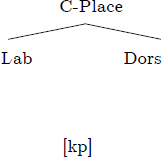 |
b. | 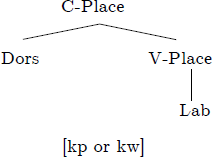 |
c. | 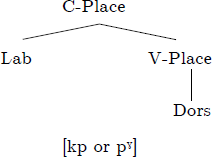 |
|
In BEG, however, (33c) should never be found as a segment. KP should either show no headedness effects or be headed. But Dors could never be headed over Lab, since by definition the Lab is a headed Dors. This is a gap in other approaches but it is actually predicted by the labio-velar hypothesis and BEG. This is because in this theory Lab is a headed version of Dor.
As predicted by the BEG representation of KP, there are no empirical attestations of (33c), a KP that patterns as a dorsal (and not a labial) (Cahill 1999: 170). Conversely, there are languages with KP OCP restrictions that affect KP and labials, but never dorsals (ibid.).
Another argument for KP’s Lab-headedness is Amele (Papuan) that has rounding of /e/ when it occurs before /o, u, w/ and /gb/. I take this is consistent with a Lab-headed KP (the structure in 33b), though Cahill (1999) takes this to be consistent with co-equal (33a). The equivalent effect, based on (33c) is unattested: vowel-backing before both dorsals and KP.
Meanwhile, still in Amele verbal morphology also shows cases where KP [gb] is reduced to [p] word finally: fo[gb]ona ‘see.1PL.PRES’ vs. folo[p] ‘see.1PL.HAB-PAST’ (Roberts 2016: 151); further highlighting KP’s primarily Lab place of articulation.
Further support for KP’s Lab headedness comes from the natural affinity between KP and KW. In some languages, these sounds seem to either share an underlying representation or they are so similar as to be interchangeable (Migabak, Nabak both from PNG). As Clements (1991) and Cahill both note, KW is the typical historical path to KP. We have also already seen this with the Aghem (section 3.2.3.3), which could also be analysed synchronically since it involves a morphological alternation. Cahill (1999) also shows this diachronic path in Sawabatu.
| (34) | Sawabatu historical KP formation (Cahill 1999: 166) | |||
| Eastern Sawabatu | Western Sawabatu | |||
| a. | koɓo | kowo | ‘skin’ | |
| b. | kúɓwako | kúgbako | ‘diarrhea’ | |
| c. | kwátá | kpátá | ‘sword’ | |
Data supporting the Labial-headed KP is also attested from Asia where KP is incredibly rare. In Asia, KP is attested only in two (unrelated) languages: Vietnamese and Adu (Yi) (Hayek 2009).
In Vietnamese, [kp] and [ŋm] occur word-finally as allophones of /k/ and /ŋ/ (Thompson 1959; Hayek 2009) but they only do so after round vowels: /xɔŋ/ [xauŋm] ‘bent over’ & /hɔk/ [haukp] ‘study’ (Hayek 2009: 218). My interpretation of these facts is that the |U| of the vowel spreads into the final consonant if it only contains a headless |U|. These are then shifted to the headed variant: /hɔk|U|/ ➔ /hɔk|U|/ ⇔ [haukp] ‘study’. According to this explanation, final labials (unlike velars) would be unaffected because they would already be headed with |U|: [hʊp|U|] ‘sink in water’, [ɲum|U|] ‘pinch of a substance’.
Adu (Yi) a Tibeto-Burman language of Southern China is a language with an impressive set of labial-velars: [kp, kpʰ, gb, ŋgb, ŋm] (Pān 2001; Matisoff 2006: 1). Historically, these all come from reconstructed sequences of *k, *g plus a round vowel (or similar) (Matisoff 2006).
| (35) | Adu labial-velars (Matisoff 2006) | |||
| Adu | Proto-Lolo-Burmese | Gloss | ||
| a. | kpu55 | *ku5 | ‘able’ | |
| b. | gbu33 | *gu7 | ‘goose’ | |
| c. | gbu33 | *gəw2 | ‘nine’ | |
| d. | kpʰu33 | *kəw1 | ‘inside’ | |
| e. | ŋgbue33 | *N-kwa | ‘lie/deceive’ | |
| f. | mu33 kpʰue33 | *kwa1 | ‘hoof’ | |
The affinity between KP and KW readily demonstrable from data drawn from African, Melanesian and South East Asia. Indeed, in some languages they are substitutable for each other. However, the representation of the two structures cannot be actually conflated with each other, because they are found contrastively in a number of languages (Mano (Khatchaturyan 2009) and Guere).
In my model, the reason for their similarity is not that they are the same structure, but that they form a class – both being headed |U|, a fact that follows from the labial-velar hypothesis and the BEG representation I offer in this paper.
4 Conclusion
In this paper I began by citing the core evidence for Element Theory’s labial-velar hypothesis, the idea that Lab and Dor share the same element as their only place feature. I additionally provided new evidence for this hypothesis in the shape of a synchronic alternation between [ɣ – p] in Lusoga, which from an articulatory perspective is a highly unnatural alternation (Hyman 2017). The same place feature surfaces with a different interpretation in its two positions. This is possible because in Bare Element Geometry a headed structure also necessarily contains a dependent of the same element. However, if velars and labials share a place feature, their contrast must be based in another property. This is taken to be headedness. For KP this leads to what might seem to be a paradoxical statement where the segment would be argued to be both headless and headed at the same time. However, according to the theory of headedness that I advanced in this paper (BEG), this is a design feature not a bug in the system. This allows KP’s root nodes to link to different parts of a structure, with Root1 linking to the whole headed structure (Lab), and the Root2 linking to only part of the structure (Dors). This representation correctly reflects the typology of (a) nasal place assimilation patterns and (b) the possibility of the incomplete nasalization of KP in Guere allophony. Once KP’s internal representation is better understood, which involved revising its phonological distribution and behaviour, the labial-velar hypothesis and the asymmetric theory of headedness actually correctly predict Cahill’s empirical observation that KP never has Dorsal being headed over Labial.
Abbreviations
1 = 1st Person, SG = Singular, PL = Plural, PST = Past.
Notes
- Hyman notes that under the influence of neighbouring Luganda [JE16], this reflex is sometimes pronounced [w]. [^]
- Subduing an element’s full expression, rather than heightening it. [^]
- Where the fact is so compelling it is a matter of description as much as it is of analysis. [^]
- The use of Set vs. Pair Merge is a thorny one in syntax, as are problems of projection in general. There are those who have argued against Pair Merge in syntax (Collins 2002; Epstein et al. 2012; Chomsky 2013; Oseki 2015). A reviewer asks for more details to be given on the homology of Merge in Phonology and Syntax, as far as this paper is concerned this issue will be decided by what is ultimately required for syntax. As far as this paper is concerned, for segment structure, Set Merge is required. [^]
- This discussion involves only two-member vocalic expressions. The implications of this model for three-member expressions such as |ø| |œ| are left to future work. [^]
- This bears some similarity to Schane (1984), where he allowed multiple instances of an element to gradiently increase an element’s phonetic prominence: |I, I, A| = [e], |I, A, A| = [ɛ]. Except that here there is counting, so there is no way to introduce a formal upper bound to contrasts: *|I, A, A, A| vs. *|I, A, A, A, A| vs. *|I, A, A, A, A, A|. [^]
- ATR is not considered to be a feature in Element Theory (Charette & Kaye 1993), Backley & Takahashi (1995). [^]
- Which mid-vowels remain depends on the dialect (Nevins 2012). [^]
- Except in certain very specific conditions such as after a stressed vowel and before a sonorant: líder *lídir ‘leader’ (Bisol & José S. de Magalhães 2002). [^]
- A reviewer points out that Breit (2013) might also have mechanisms that obviate this problem. BEG does have a distinct advantage here, however, with respect to explicitly templatic approaches. [^]
- The glide j is transcribed y in the original. [^]
- It could also have made sense as a saturation of a place node: the place node holds maximally two features. However, representationally it does not seem that ‘colouring’ affects the core of the segment, so this representational outcome is not my favoured explanation. This may not convince some readers (though it will others), but I think the arguments in the next section that KP has two root-nodes are clearer. [^]
- A reviewer mentions Limbum of Cameroon as having initial [bf], however, the reviewer also mentions that it is likely analysable as a consonant sequence rather than a segment. The same reviewer mentions the allophone of Guere: [km]. Voicing from allophonic nasalisation may constitute a counterexample, but phonemic [km] may be unattested. [^]
- This suggests that laryngeal features link directly to the timing slot (cf. Liu 2019; Liu & Kula 2020). [^]
- The closest common counterexample would be /pf/ which phonetically may appear to be bilabial, labio-dental, but the phonological feature for both is [Labial]. There are some isolated cases of affricates reported with branching place such as [pʂ, bʐ] in Xitsonga (Vratsanos & Kadenge 2017) and a number of other languages but their phonological status is unclear. [^]
- She shows two other representations with a branching supra-laryngeal node, but since this node has been done away with (McCarthy 1988), these are not considered here. [^]
- Though see: Olson (2004) that describes Mono as having N before KP/GB. [^]
- The
 ➔ symbol here is to remind the reader that the features could be drawn in either order. This is in contrast with the two root node structure shown beneath where ➔ implies precedence.
[^]
➔ symbol here is to remind the reader that the features could be drawn in either order. This is in contrast with the two root node structure shown beneath where ➔ implies precedence.
[^]
- Depending on the framework, I guess it is a priori possible for the sub-skeletal/sub-Root node features to be extrinsically orderable, however, this is not what is empirically observed. Outside of the framework of Articulatory Phonology (Browman & Goldstein 1986; 1992), not even the occlusive and continuancy features of affricates are believed to be ordered (Lombardi 1990). Indeed, it is vital to conserve the insight from Sagey (1986), that there is no ordering of features below the root node. To accept anything else would open the door to phonological contrasts that are simply unattested: /t/ with and without ordering. Therefore, the ordering of place features in KP cannot be as a result of ordering within a branching place node (a terminal node), the ordering must come from ‘on high’. This is especially important to Element Theory where Backley (2011) convincingly shows us that certain consonants have ‘complex resonance’ (equivalent to a branching place node). [^]
- The root is underlined. [^]
- McCarthy (1988) simplifies feature geometry in a way that is identical to the conclusions of Harris & Lindsey (1995): a root node has a place and laryngeal node and the other manner features attach directly to the root. [^]
- Others link nasal still higher, Schleicher (1990), for instance, proposes to attach it to the skeletal slot. But this is not entertained here. [^]
- Leftward nasalisation of only the dorsal half of the KP is predicted to be impossible. [^]
- If the two-root is dominated by a skeletal slot linked to a voice feature, it attracts nasality and global nasalisation ensues, otherwise it links locally to Root2 dominating Lab. [^]
- Melody made of Place or Manner features must be binary branching, however, the Root and x-slot are linked to melody by association lines, not built by Merge, they are not endocentric. Roots/x’s can link to multiple objects. [^]
- A reviewer asks about placement of Laryngeal (Lar). In light especially of Liu (2019), I have placed Lar directly at the x-slot. This correctly captures the voicing facts of KP (sharing voicing). [^]
Competing Interests
The author has no competing interests to declare.
References
Adger, David. 2013. A Syntax of Substance. Cambridge (MA): MIT Press. DOI: http://doi.org/10.7551/mitpress/9780262018616.001.0001
Anderson, John M. & Ewen, Colin M. 1987. Principles of dependency phonology. Cambridge: Cambridge University Press. DOI: http://doi.org/10.1017/CBO9780511753442
Anderson, John M. & Jones, Colin. 1974. Three theses concerning phonological representations. Journal of Linguistics 10. 1–26. DOI: http://doi.org/10.1017/S0022226700003972
Ansre, Gilbert. 1963. Reduplication in Ewe. Journal of African Languages 2. 128–132.
Archangeli, Diana & Puleyblank, Douglas. 1986. The Content and Structure of Phonological Representations (ms.). Universities of Arizona and of Southern California.
Backley, Phillip. 2011. An Introduction to Element Theory. Edinburgh: Edinburgh University Press.
Backley, Phillip. 2017. Headedness in Element Theory: the case for multiple heads. Glossa: a journal of general linguistics 2(1). 89. DOI: http://doi.org/10.5334/gjgl.463
Backley, Phillip & Nasukawa, Kuniya. 2009. Representing labials and velars: a single ‘dark’ element. Phonological Studies 12. 3–10.
Backley, Phillip. & Takahashi, Toyomi. 1995. Activate Alpha: harmony without spreading. UCL Working Papers in Linguistics 8. 487–518.
Bisol, Leda & de Magalhães, José S. 2002. Vowel reduction in Brazilian Portuguese. (ms.). Pontifícia Univ. Católica do Rio Grande do Sul and Univ. Federal de Uberlândia-MG.
Botma, Bert. 2004. Phonological Aspects of Nasality: An element-based dependency approach. Utrecht: LOT.
Breit, Florian. 2013. Formal Aspects of Element Theory. MRes Dissertation, UCL – University of London.
Browman, Catherine P. & Goldstein, Louis. 1986. Towards an articulatory phonology. Phonology Yearbook 3. 219–252. DOI: http://doi.org/10.1017/S0952675700000658
Browman, Catherine P. & Goldstein, Louis. 1992. Articulatory phonology: An overview. Phonetica 49. 155–180. DOI: http://doi.org/10.1159/000261913
Cahill, Michael. 1999. Aspects of the phonology of labial-velar stops. Studies in African Linguistics 28(2). 155–184.
Casali, Roderic F. 2008. ATR Harmony in African Languages. Language and Linguistics Compass 3(1). 496–549. DOI: http://doi.org/10.1111/j.1749-818X.2008.00064.x
Charette, Monik & Göksel, Aslı. 1996. Switching and vowel harmony in Turkic languages. In Kardela, Henryk & Szymanek, Bogdan (eds.), A Festschrift for Edmund Gussmann, 29–57. Lublin: Wydawnictwo KUL.
Charette, Monik & Göksel, Aslı. 1998. Licensing constraints and vowel harmony in Turkic languages. In Cyran, Eugeniusz (ed.), Structure and interpretation: Studies in phonology (PASE Studies and Monographs), 65–89. Lublin: Folium.
Charette, Monik & Kaye, Jonathan. 1993. Death to ATR. (ms.) SOAS – University of London.
Chomsky, Noam. 1993. A Minimalist Program for Linguistic Theory. In Hale, Kenneth & Keyser, Samuel Jay (eds.), The view from building 20: Essays in linguistics in honor of Sylvain Bromberger, 1–52. Cambridge, MA: MIT Press.
Chomsky, Noam. 1995. The Minimalist Program. Cambridge, MA: MIT Press.
Chomsky, Noam. 2011. On the poverty of the stimulus. Talk presented at UCL – University of London.
Chomsky, Noam. 2013. Problems of Projections. Lingua 130. 33–49. DOI: http://doi.org/10.1016/j.lingua.2012.12.003
Chomsky, Noam. 2014. Syntax Session. Talk @ Keio Linguistics Colloquium. Keio University.
Chomsky, Noam & Berwick, Robert C. 2016. Why only us? Cambridge (MA): MIT Press. DOI: http://doi.org/10.7551/mitpress/9780262034241.001.0001
Clements, George N. 1985. The Geometry of Phonological Features. Phonology Yearbook 2. 225–252. DOI: http://doi.org/10.1017/S0952675700000440
Clements, George N. 1991. Vowel height assimilation in Bantu languages. Working Papers of the Cornell Phonetics Laboratory 5. 37–76.
Collins, Chris. 2002. Eliminating Labels. In Epstein, Samuel D. & Seely, Daniel (eds.), Derivation and Explanation in the Minimalist Program, 42–64. Oxford: Blackwell. DOI: http://doi.org/10.1002/9780470755662.ch3
Crane, Thera & Hyman, Larry M. & Tukumu Simon N. 2011. A Grammar of Nzadi [B865]: A Bantu Language of Democratic Republic of Congo. University of California Press.
Den Dikken, Marecel & van der Hulst, Harry. 2020. On some deep structural analogies between syntax and phonology. In Nasukawa, Kuniya (ed.), Morpheme-internal Recursion in Phonology. Berlin: Mouton de Gruyter.
Epstein, Samuel D. & Kitahara, Hisatsugu & Seely, Daniel T. 2012. Structure Building That Can’t Be. In Uribe-Etxebarria, Myriam & Valmala, Vidal (eds.), Ways of Structure Building, 253–270. Oxford: Oxford University Press.
Faust, Noam. 2017. Get that into your head: Tigre vowel harmonies as templatic. Glossa: a journal of general linguistics 2(1)–95. DOI: http://doi.org/10.5334/gjgl.466
Gold, Jana Willer & Arsenijevic, Boban & Batinić, Mia & Becker, Michael & Čordalija, Nermina & Kresić, Marijana & Leko, Nedžad & Marušič, Franc Lanko & Milićev, Tanja & Milićević, Nataša & Mitić, Ivana & Peti-Stantić, Anita & Stanković, Branimir & Šuligoj, Tina & Tušek, Jelena & Nevins, Andrew. 2017. When linearity prevails over hierarchy in syntax. PNAS. http://www.pnas.org/content/pnas/early/2017/12/28/1712729115.full.pdf.
Hagège, Claude. 1970. La langue mbum de Nganha (Cameroun). Société d’Études Linguistiques et Anthropologiques de France, 18–19.
Hale, Mark & Reiss, Charles. 2008. The Phonological Enterprise. Oxford: Oxford University Press.
Halle, Morris & Vergnaud, Jean-Roger. 1980. Three-dimensional phonology. Journal of Linguistic Research 1. 83–105.
Harris, John. 1994. English Sound Structure. Oxford: Blackwell.
Harris, John. 1997. Licensing Inheritance: an integrated theory of neutralization. Phonology 14. 315–370. DOI: http://doi.org/10.1017/S0952675798003479
Harris, John & Lindsey, Geoff. 1995. The elements of phonological representation. In Durand, Jacques & Katamba, Francis (eds.), Frontiers of Phonology, 34–79. Harlow, Essex: Longman.
Harris, John & Urua, Eno-Abasi. 2001. Lenition degrades information: consonant allophony in Ibibio. Speech, Hearing and Language: Work in progress 13. 72–105.
Hayek, John. 2009. On labial-velar stops and nasals in Vietnamese. Mon-Khmer Studies 38. 217–221.
Hyman, Larry M. 2017. Underlying representations and Bantu segmental phonology. In: Lindsey, Geoff & Nevins, Andrew (eds.), Sonic Signatures, 101–116. Amsterdam: John Benjamins Publishing Company. DOI: http://doi.org/10.1075/lfab.14.c6
Jakobson, Roman & Halle, Morris. 1956. Fundamentals of Language. ‘s Gravenhage: Mouton.
Kaye, Jonathan. 2001. Working with licensing constraints. In Dziubalska-Kolaczyk, Katarzyna (ed.), Constraints and Preferences, 251–268. Berlin & New York: Mouton de Gruyter.
Kaye, Jonathan. 2005. GP, I’ll have to put your flat feet on the ground. In Broekhuis, Hans & Corver, Norbert & Huybregts, Riny & Kleinhenz, Ursula & Koster, Jan (eds.), Organizing Grammar. Studies in Honor of Henk van Riemsdijk, 283–288. Berlin: Mouton de Gruyter. DOI: http://doi.org/10.1515/9783110892994.283
Kaye, Jonathan & Lowenstamm, Jean & Vergnaud, Jean-Roger. 1990. Constituent structure and government in phonology. Phonology Yearbook 7. 193–231. DOI: http://doi.org/10.1017/S0952675700001184
Khatchaturyan, Maria. 2009. La phonologique segmentale du mano guineen, 403–416. Musee d’anthropologie et d’ethnographie. (unpublished).
Liu, Xiaoxi. 2019. An Element-geometry Approach to Depressors in Bantu & Chinese. PhD thesis, University of Essex.
Liu, Xiaoxi & Kula, Nancy. 2020. Multi-layered recursive representations for depressors. Nasukawa, Kuniya (ed.), Morpheme-internal Recursion in Phonology, 143–180. Berlin: Mouton de Gruyter. DOI: http://doi.org/10.1515/9781501512582-006
Lombardi, Linda. 1990. The Nonlinear Organization of the Affricate. Natural Language and Linguistic Theory 8. 375–425. DOI: http://doi.org/10.1007/BF00135619
Lowenstamm, Jean. 1996. CV as the only syllable type. In Durand, Jacques & Laks, Bernard (eds.), Current Trends in Phonology: Models and Methods, 419–441. Salford, Manchester: ESRI.
Matisoff, James A. 2006. Much Adu about something: extrusional labiovelars in a Northern Yi patois. Linguistics of the Tibeto-Burman Area 29(1). 95–106.
McCarthy, John J. 1988. Feature geometry and dependency: A review. Phonetica 45(2–4). 84–108. DOI: http://doi.org/10.1159/000261820
Mills, Elizabeth. 1984. Senoufo phonology, discourse to syllable (a prosodic approach). SIL publications in linguistics. 72.
Morton, Deborah. 2012. [ATR] Harmony in an Eleven Vowel Language: The Case of Anii. In Selected Proceedings of the 42nd Annual Conference on African Linguistics, 70–78. Somerville, MA: Cascadilla Proceedings Project.
Mve, Jean P. 2013. Aspects of the phonology of Fáŋ (draft version). Master’s thesis, University of Yaoundé. https://www.acsu.buffalo.edu/~jcgood/Mve-2013-Fang.pdf
Nasukawa, Kuniya. 2005. A unified approach to nasality and voicing. Berlin: Mouton de Gruyter. DOI: http://doi.org/10.1515/9783110910490
Nasukawa, Kuniya. 2014. Features and Recursive Structure in Phonology. Proceedings of the 2013 Annual Meeting on Phonology 2013, 1–11. DOI: http://doi.org/10.3765/amp.v1i1.25
Nevins, Andrew. 2010. Locality in Vowel Harmony. Cambridge (MA): MIT Press. DOI: http://doi.org/10.7551/mitpress/9780262140973.001.0001
Nevins, Andrew. 2012. Vowel lenition and fortition in Brazilian Portuguese. Letras de Hoje 47(3). 228–233.
Olson, Kenneth S. 2004. Illustrations of the IPA: Mono. Journal of the International Phonetic Association 34(2). 233–238. DOI: http://doi.org/10.1017/S0025100304001744
Olson, Kenneth S. 2005. The phonology of Mono. Dallas: SIL International and the University of Texas at Arlington.
Oseki, Yohei. 2015. Eliminating Pair-Merge. In Proceedings of the 32nd West Coast Conference on Formal Linguistics, 303–312. Somerville, MA: Cascadilla Proceedings Project.
Pān, Zhengyun. 2001. Yi-yu Adu-hua chunruan-e fufuyin shengmu bijiao yanjiu – [A comparative study of labiovelar cluster initials in the Adu patois of the Yi language]. Minzu Yuwen 2. 17–22.
Paradis, Carole. 1983. Description Phonologique du Guéré. No 102. ILA, Institut de linguistique appliquée de l’Université d’Abidjan.
Pierrehumbert, Janet. 2011. Representation in Phonology. Talk presented at 50 years of Linguistics at MIT. MIT.
Piggott, Glynne. 1987. On the Autonomy of the Feature Nasal. In Proceedings of the Parasession on Autosegmental and Metrical Phonology, Chicago Linguistic Society 23, 223–239. Chicago: Chicago University Press.
Ploch, Stefan. 1999. Nasals on my mind. Ph.D Thesis. SOAS – University of London.
Pöchtrager, Markus A. 2018. Sawing off the branch you are sitting on. Acta Linguistica Academica 65(1). 47–68. DOI: http://doi.org/10.1556/2062.2018.65.1.3
Price, Norman. 1989. Notes on Mada Phonology. Dallas: Summer Institute of Linguistics.
Roberts, John R. 2016. Amele RRG Grammatical Sketch. SIL, International.
Sagey, Elizabeth C. 1986. The Representation of Features and Relations in Non-linear Phonology. Ph.D. Thesis, MIT.
Schane, Sanford. 1984. The Fundamentals of Particle Phonology. Phonology Yearbook 1. 129–155. DOI: http://doi.org/10.1017/S0952675700000324
Scheer, Tobias. 2004. A Lateral Theory of Phonology. Vol 1: What is CVCV, and why should it be? Berlin: Mouton de Gruyter. DOI: http://doi.org/10.1515/9783110908336
Scheer, Tobias. 2013. Why phonology is flat: the role of concatenation and linearity. Language Sciences 39. 54–74. DOI: http://doi.org/10.1016/j.langsci.2013.02.004
Thompson, Laurence C. 1959. Saigon Phonemics. Language 35(3). 454–476. DOI: http://doi.org/10.2307/411232
van der Hulst, Harry. 1989. Atoms of segmental structure: components, gestures and dependency. Phonology 6. 253–284. DOI: http://doi.org/10.1017/S0952675700001020
van der Hulst, Harry. 2010. A note on recursion in phonology. In Van der Hulst, Harry (ed.), Recursion and Human Language, 301–342. Berlin: Mouton de Gruyter. DOI: http://doi.org/10.1515/9783110219258
van der Hulst, Harry. 2020. Principles of Radical CV Phonology. Edinburgh: Edinburgh University Press.
van de Weijer, Jeroen. 1996. Segmental structure and complex segments. Tübingen: Niemeyer. DOI: http://doi.org/10.1515/9783110955293
Vratsanos, Alyssa & Kadenge, Maxwell. 2017. Hiatus resolution in Xitsonga. Stellenbosch Papers in Linguistics Plus 52. 175–196. DOI: http://doi.org/10.5842/52-0-711
Welmers, William E. 1977. A Grammar of Vai. University of California Press.
Yoshida, Yoshida. 2019. 大阪・京都方言における撥音とピッチ・アクセント [Pitch Accent on /N/ in Osaka and Kyoto Japanese]. Kansai Linguistic Society, Selected Papers 1.

